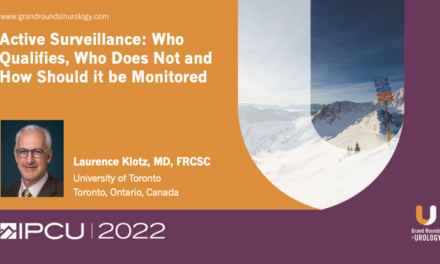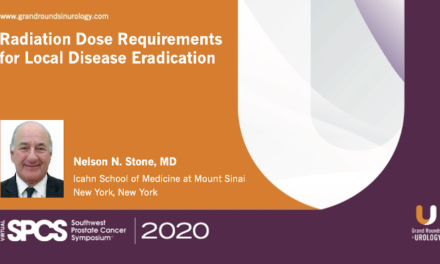Abhinav Sidana, MD, presented “Selecting Candidates for Focal Therapy” during the 2022 Frontiers in Oncologic Prostate Care and Ablative Local Therapy symposium on September 23, 2022, in Los Angeles, California.
How to cite: Sidana, Abhinav. “Selecting Candidates for Focal Therapy.” September 23, 2022. Accessed Oct 2024. https://grandroundsinurology.com/selecting-candidates-for-focal-therapy/
Selecting Candidates for Focal Therapy – Summary
Abhinav Sidana, MD, Assistant Professor of Surgery, Director of Urologic Oncology, and a urologic surgeon at the University of Cincinnati Medical Center in Ohio, discusses criteria for the selection of candidates for focal therapy, including imaging modalities for focal therapy screening, biopsy strategies to determine focal therapy candidacy, and optimal characteristics for treatment. He begins by citing guidelines and points out that EAU Prostate Cancer guidelines (2022) say that focal therapy should only be offered within a clinical trial or well-designed prospective cohort and the NCCN Prostate Cancer guidelines (2022) don’t recommend focal therapy as a routine primary therapy due to lack of long-term, comparative data. Dr. Sidana discusses imaging and states that multiparametric magnetic resonance imaging (mpMRI) can help identify clinically significant cancers, localize lesions, assess volume, and risk stratify patients. Dr. Sidana points out that, when used with systematic biopsy, mpMRI can detect 96 percent of index tumors. Next, he discusses selection based on disease and patient characteristics, explaining that the ideal patient has a life expectancy of >10 years and has unifocal, unilateral, or anterior disease. Additionally, patients with intermediate-risk prostate-specific antigen (PSA), MRI-visible, clinically significant disease with an absence of high-risk features with disease that is isolated from vital structures also tend to be good candidates. He states that patients are good candidates for focal therapy if conditions support the destruction of all clinically significant cancer with preservation of at least one neurovascular bundle and urethral sphincter. Dr. Sidana then presents various focal therapy templates and explains that patients with an index cancer as well as a significant lesion on opposite sides of the prostate would not be good candidates for focal therapy due to higher risk of failure. He emphasizes the importance of the selection of energy modality in the ability to offer and deliver effective focal therapy for various cancer locations and gland sizes. Dr. Sidana closes by emphasizing his take-home points regarding candidate selection for focal therapy: prostate mpMRI should be followed by guided biopsy (and in the absence of mpMRI, a template mapping biopsy should occur), ideal cancers are unifocal or unilateral Gleason-Grade (GG) 2-3, the goal should be to preserve at least one neurovascular bundle and avoid injury to the urethra and sphincter, and planned treatment should not spare any ≥GG2 cancer outside of the treatment zone.
The annual symposium on Frontiers in Oncologic Prostate Care and Ablative Local Therapy (FOCAL) is an outstanding program on prostate imaging, transperineal interventions, and ablative treatments for prostate cancer and benign prostatic hyperplasia. Bringing together community-based, academic, and industry partners, FOCAL offers lectures by world-renowned faculty and hands-on training workshops on in-office transperineal interventions, fusion-guided prostate ablation and state-of-the-art BPH management with novel technologies. For more educational activities from the symposium that took place from September 23-24, 2022 in Los Angeles, California, visit our collection page.
ABOUT THE AUTHOR
Abhinav Sidana, MD, MPH, is the Director of Prostate Cancer Focal Therapy, Director of GU Clinical Trials Urology Section, and Associate Professor of Surgery at the University of Chicago Medicine and Biological Sciences in Chicago, IL. Dr. Sidana earned his MD in 2007 from the All India Institute of Medical Sciences in New Delhi. Following this, he pursued a post-doctoral Fellowship in Urology at Johns Hopkins University School of Medicine in Baltimore, Maryland, during which he focused on translational projects relating to cancer immunotherapy and was instrumental in translating the preclinical work for a clinical trial studying cryo-immunotherapy. Subsequently, he completed his urology residency at the University of Cincinnati Medical Center and a urologic oncology fellowship at the National Cancer Institute of the National Institutes of Health. Dr. Sidana’s current clinical practice includes both surgical and non-operative management of prostate, kidney, ureteral, testicular, and bladder cancers. His research interests include functional prostate imaging, image-guided and focal treatments for prostate cancer, and clinical trials on novel treatments for urologic cancers.



